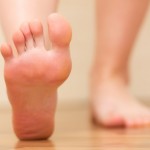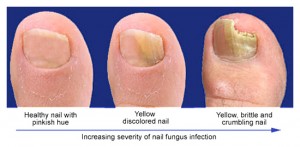 Fungal nail infections is a topic that not many people are comfortable talking about, but is something we should all be aware of. Fungal infections can affect any part of the body, and the organisms that cause toenail fungus are common inhabitants of our everyday environment; commonly occurring in showers, hotels and outdoors, so the chance of exposure is high. Fungi are normally present in and on the body, alongside various bacteria, and when a fungus begins to overgrow, it causes an infection.
Fungal nail infections is a topic that not many people are comfortable talking about, but is something we should all be aware of. Fungal infections can affect any part of the body, and the organisms that cause toenail fungus are common inhabitants of our everyday environment; commonly occurring in showers, hotels and outdoors, so the chance of exposure is high. Fungi are normally present in and on the body, alongside various bacteria, and when a fungus begins to overgrow, it causes an infection.
Onychomycosis (on-ih-koh-my-KOH-sis) or Tinea Unguium, is a fungal infection that affects either the fingernails or toenails. Fungal infections normally develop over time, so any immediate difference in the way your nail looks or feels may be too subtle to notice at first. In some people, the fungus can also spread to the surrounding skin, causing athlete’s foot (or Tinea Pedis) and sometimes the fungus can be passed to the genitals (known as Jock Itch). This happens when underwear is pulled on over the infected toenails, so if your toenails are infected, put socks on before you put on your underwear!
Onychomycosis is a common condition that begins as a white or yellow spot under the free edge (tip) of your fingernail or toenail and can affect one nail or several nails but usually not all of them and most often it appears on the great toenail or the little toenail. As the fungal infection spreads and goes deeper, the fungus may cause your nail to discolour, thicken and begin crumbling towards the edges.
A severe case of nail fungus can be very painful and may cause permanent damage to your nails, as well as possibly leading to other serious infections that spread beyond your feet, especially if you have a suppressed immune system due to medication, diabetes or other medical conditions.

“Onychomycosis may affect one or more toenails and/or fingernails and most often involves the great toenail or the little toenail. It can present in one or several different patterns:
- Lateral onychomycosis. A white or yellow opaque streak appears at one side of the nail.
- Subungual hyperkeratosis. Scaling occurs under the nail.
- Distal onycholysis. The end of the nail lifts up. The free edge often crumbles.
- Superficial white onychomycosis. Flaky white patches and pits appear on the top of the nail plate.
- Proximal onychomycosis. Yellow spots appear in the half-moon (lunula).
- Onychoma or dermatophytoma. This is a thick localised area of infection in the nail plate.
- Complete destruction of the nail.” – (Source: DermNet NZ)
Because there are other infections that can affect the nail and mimic symptoms of fungal nail infection, the only way to confirm a diagnosis is to see your doctor. Over-the-counter products aren’t usually recommended to treat nail infections because they don’t provide reliable results. Instead, your doctor may prescribe an oral anti-fungal medication.
There are a few factors that can increase your risk of developing nail fungus and these include:
* Being older, due to reduced blood flow, more years of exposure to fungi and slower growing nails.
* Perspiring heavily
* Being male, especially if you have a family history of nail fungal infections
* Working in a humid or moist environment or in a job where your hands are often wet, such as bartending or housekeeping
* Wearing socks and shoes that hinder ventilation and don’t absorb perspiration
* Living with someone who has nail fungus
* Picking at your nails or the skin around your nails, as this can expose you to infection. If you already have a fungal nail infection, picking at the crumbling or affected nail will cause the infection to spread to other nails. Picking at your infected nails also exposes others to infection, as these bits of infected nail are then stepped on and spread around.
* Walking barefoot in damp communal areas, such as swimming pools, gyms and shower rooms
* Having athlete’s foot
* Having a minor skin or nail injury or a skin condition, such as psoriasis
* Having diabetes, circulation problems, a weakened immune system or, in children, Down syndrome
If you do have a fungal nail infection or something that resembles a fungal nail infection, please do the responsible thing and have your doctor look at it. Don’t leave it alone in the hopes that it will go away on its own, as you’ll just continue to unknowingly spread any present infection to other people, as well as possibly spread the infection from one nail to another, or even from your toenails to your fingernails or other body parts.
Please note that your nail technician is not qualified to diagnose fungal nail infections, so if you have any unusual discolouration on your nails, please don’t make an appointment to have a manicure or pedicure, rather make an appointment to see your doctor first. If you do happen make a nail appointment and you have something that resembles a possible nail infection, your nail technician will be unable to do your nails, and should refer you to your doctor before any further nail services can be carried out. This is for your own safety, as well as the safety of the nail technician and their other clients.










Leave a Reply
You must be logged in to post a comment.